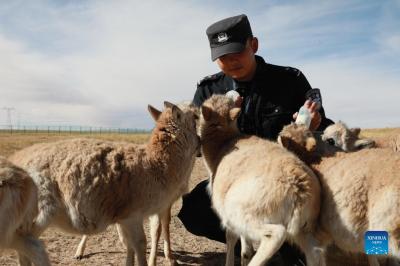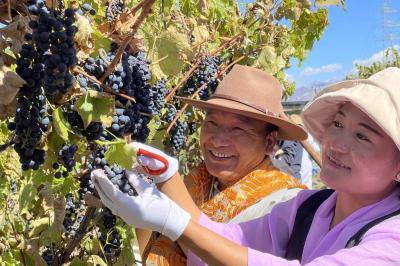 Karma Chodrak, an artisan of Tibetan woodblock engravings who is from Nyemo county in the Tibet autonomous region, holds a wooden carving. PALDEN NYIMA/CHINA DAILY
One of the rooms in Karma Chodrak's house is like a private museum, with woodblock works of art and a canvas of masterful calligraphy on display. Various colored pots of ink, well-worn carving tools and intricate Buddhism-themed woodblocks passed down from his ancestors also decorate the space. Karma Chodrak is a farmer in Phusum, in the Tibet autonomous region, and also a renowned woodblock craftsman and calligrapher.
"I spend much of my time at the workshop in my home carving; carving has become part of my life," said the 37-year-old, who was born in Phusum, a town of 2,400 residents in Nyemo county.
Phusum, with its rich heritage of Tibetan engraving, crafts, artisans and ethnic culture, is known as the "Woodblock Township". The town, 150 kilometers from the regional capital Lhasa, has more than 90 men and five women skilled in making woodblock crafts.
Nyemo was also the home of Thonmi Sambhota, one of the ministers of the Tibetan king Sontsan Gampo 1,400 years ago, who is regarded by many as the inventor of the Tibetan script.
It is said that the history of Phusum's carving can be traced back to the seventh century. It is known as one of the "three best features" of Nyemo, with the other two being Tibetan paper and incense.
Traditionally, the content of Tibetan woodblock carvings can be divided into Buddhist scriptures, Buddhist statues and folklore. The woodblocks have multiple applications and are used for architectural decoration, printing and for sealing Buddhist scriptures.
Learning advantage
In Karma Chodrak's family, the ancient skill has been passed down for more than four centuries and he is the sixth-generation inheritor of the art.
He started to learn woodblock techniques when he was 13 from his father Dorjee Chochel and his older brother Penpa Rabten. The learning process was so painstaking that he developed thick calluses on his hands and he considered giving it up.
"My father and brother were very strict. I would be punished if I showed any sign of slowing down because they knew that it was very important to train me to become a qualified successor of the age-old family tradition," he said.
He took six years to learn the skills and techniques involved in woodblock carving.
Nowadays, he and his brother carry on the family tradition. He has plans to teach his three daughters, ages 13, 11 and 10, the skills after they have completed their education.
"Sometimes when I encounter difficulties while carving, I feel frustrated. However, when I think of my responsibility of passing on the cultural practice to future generations, I cheer up," Karma Chodrak said.
Traditionally, woodblock craftsmen receive orders to make woodblocks for scripture from monasteries. The orders sometimes keep them busy for a few months to several years and provide a good income.
With the growth of the tourism sector in recent years, woodblock craftsmen have started producing tourism-related products to help them earn money.
In 2009, the woodblock carving of Phusum was listed as one of Tibet's regional intangible cultural heritage and Karma Chodrak began to carve cultural products to sell to tourists.
"In line with cultural sustainability, I have been trying to become more involved with tourism in recent years. I have created many products for tourists using traditional carving skills and materials. It is very important to make sure the ancient art survives in modern society," he said.
Karma Chodrak does not have a shop, but his clients come from all over China. Some wait two to three years to have their orders delivered.
Lasting legacy
Losang Tashi, a professor in the Department of Fine Arts at Tibet University, has collected some of Karma Chodrak's works. The woodblock engravings are part of the permanent collection of the university and are an important resource for teachers and students who are keen to study techniques involved in the craft.
"His woodblock engravings are distinct from other works with accurate modeling measurements, vivid images, a skillful knife technique, a standardized pattern design and exquisite carving skills," Losang Tashi said.
In 2014, Karma Chodrak was recognized as a city-level intangible culture inheritor by the government, earning him an annual subsidy of 2,500 yuan ($390).
"Apart from the subsidies, cultural inheritors are given the opportunities of displaying their cultural works in various places in China, with all the traveling costs being covered by the authorities," he said.
In 2018, Karma Chodrak was recognized as an outstanding member of the Communist Party of China for his contributions to helping poor farmers in his village out of poverty.
In 2016, he established a cooperative in his village to encourage other farmers to generate more income by getting involved in woodblock carving. The cooperative has 12 permanent workers, who earn a monthly salary ranging from 3,000 to 6,000 yuan.
Two farmers have become woodblock craftsmen.
"I have been receiving support from the local government and my fellow villagers all the time, and many of our villagers have become wealthier by engaging in this work," he said.
By PALDEN NYIMA and DAQIONG in Lhasa |
- Home
- News Tibet |Exclusive |China |World |Related News |Latest
- Documents White Papers |Others
- Photo Politics |Economy & Society |Culture & Religion |Human & Nature |Beautiful Tibet |Other Tibetan-Inhabited Area |Exchanges |Related
- Video News |Documentary |Micro-Video |Entertainment
- Art
- Tourism
- In Focus
- About Tibet






